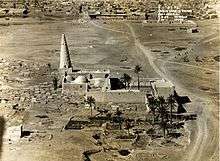Shahab al-Din Abu Hafs Umar Suhrawardi
| Shahāb al-Din Abu Hafs Umar Suhrawardi | |
|---|---|
| Religion | Islam, Sunni |
| Denomination | Sunni |
| Order | Suhrawardi Sufi Order |
| Other names | Shahabudin, Shahabuddin, Soharwardi, al-Suhrawardi, Soharwardy, Shahab ad-Din |
| Personal | |
| Born |
1145 Sohrevard, Abbasid Caliphate, now Khodabandeh County, Zanjan Province, Iran |
| Died |
1234 (aged 89) Baghdad, Abbasid Caliphate, now Iraq |
| Senior posting | |
| Title | Shaykh al-Islam |
| Period in office | 12th-13th century |
Part of a series on Islam Sufism |
|---|
|
|
List of sufis |
|
|
Shaykh Shahab al-Din Abu Hafs Umar Suhrawardi (c.1145-1234) was a Persian[1][2] Sufi and nephew of Abu al-Najib Suhrawardi. He expanded the Sufi order of Suhrawardiyya that had been created by his uncle Abu al-Najib Suhrawardi, and is the person responsible for officially formalizing the order.[3] Suhrawardi is the author of the Awarif ul-Maarif, which is recognized as a masterpiece work in Tasawwuf.
Other transliterations: Shaykh Shihab al-Din ‘Umar al-Suhrawardi, Shaykh 'Abu Hafs al-Suhrawardi, Hadrat Shaykh Shihab al-Din `Umar b. `Abd Allah al-Suhrawardi, Shaykh Shahabuddin Abu Hafs Umar Suhrawardi, Shaykh Shahabuddin Abu Hafs Umar Soharwardi, Shaykh Shahabuddin Abu Hafs Umar Soharwardy, Shaykh Shahabuddin Soharwardi, Shaykh Shahabuddin Soharwardy, Shaykh Umar Shahabuddin Soharwardi.
Life
Suhrawardi traces his lineage back to Abu Bakr, the first Caliph.[4] From an early age onwards, Suhrawardi studied Islamic jurisprudence, law, logic, theology, Quranic studies and Hadith studies.[3] Suhrawardi quickly excelled in his studies and mastered, at an early age, the Shafi'i and Hanbali madhabs.[3] One of his most notable teachers was the famous Sufi, Abdul Qadir Jilani.[3] Suhrawardi was eventually designated as Shaykh al-Islam by al-Nasir under the Abbasids.[3]
The Awarif ul Maarif
Suhrawardi wrote the Awarif ul-Maarif, or "The Knowledge of the Spiritually Learned."[5][6] The Awarif ul-Maarif quickly became one of the most popular books on Sufism throughout the Muslim world. This book was translated into English by Henry Wilberforce-Clarke and published as "A Dervish Textbook" in 1891. It was reprinted by Octagon Press in 1980.
Gallery
 Umar Al Suhrawardi's tomb in Baghdad 1924
Umar Al Suhrawardi's tomb in Baghdad 1924 Umar Al Suhrawardi's tomb in Baghdad 1924
Umar Al Suhrawardi's tomb in Baghdad 1924
References
- ↑ Medieval Islamic Civilization: An Encyclopedia. New York: Routledge. 2006. p. 775. ISBN 0415966906. Retrieved 2015-03-19.
- ↑ John Renard, "Historical dictionary of Sufism ", Rowman & Littlefield, 2005. pg xxviii. excerpt: "Abu 'n-Najib 'Abd al-Qahir as-Suhrawardi, Persian shaykh and author, and scholar who thought Ahmad al-Ghazali, Najm al-Din Kubra and Abu Hafs 'Umar as-Suhrawardi
- 1 2 3 4 5 Medieval Islamic Civilization: An Encyclopedia (2006), p. 775
- ↑ Sheikh Shahabudin Umar Soharwardi
- ↑ Medieval Islamic Civilization: An Encyclopedia (2006), p. 776
- ↑ Silsila-e-Suhrawardiya
Bibliography
- Ohlander, Erik, Sufism in an Age of Transition: Umar al-Suhrawardi and the Rise of the Islamic Mystical Brotherhood (Leiden, Brill, 2008) (Islamic History and Civilization, 71).
- Huda, Qamar-ul, Striving for Divine Union: Spiritual Exercises for Suhrawardī Sūfīs (Psychology Press, 2003)
External links
- Translation of the Awarif Al-Maarif at archive.org.
- Silsilae Suhrawardiya